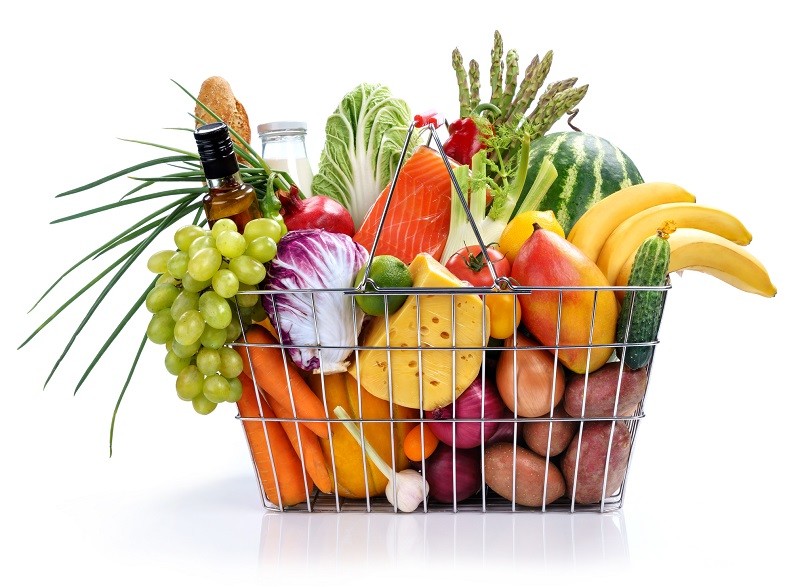Family & children
Learning together and having fun with healthy choices.
Healthy nutrition for the whole family
As parents, you only want the best for your family, especially when it comes to health. Between home, work and family commitments, time is often limited.
Despite the time pressure, however, you still want to be a role model for your children, satisfy all their tastes and fulfil all their desires – without neglecting your own needs. This is easier said than done.
However, it is precisely in such stressful life situations that a balanced diet is crucial. It provides energy for everyday life and gives you more quality of life and enjoyable moments with your loved ones.

Do something good for yourself and your family
7 Principles for successful implementation
- Teach your child a healthy diet at an early age so that it becomes an integral and natural part of his or her everyday life.
- Involve the whole family in all the preparation processes – from shopping to cooking and laying the table. This will lighten your workload and give you a beautiful, shared family experience.
- Be a positive role model and remember that parents have an enormous influence on your children’s eating habits.
- Let us inspire you! Metabolic Balance’s individual nutrition plan, for example, gives you many healthy recipe ideas and valuable suggestions.
- Be creative! Cook with colourful vegetables, make dishes that are suitable for children and choose simple recipes that you can easily change to cater to their tastes and food tolerances.
- Shop regionally, seasonally and conscientiously! You The seasonal calendar tells you when you can buy fresh and inexpensive local products.
- Use planning tools to save time, money and stress. It might be a conventional shopping list, weekly menu or a practical app – choose a planning aid that suits you.

Losing weight together with the family - a great route to success
Let’s say that you or your partner want to lose weight – but how can a change in diet be integrated into everyday life if the whole family has to be taken into consideration? You can do this easily with just a few tricks, a little creativity and some good planning.
It’s important to celebrate the family experience so that everyone can enjoy it. Shop together, cook together and motivate all the family to start sporting activities together. Also get some inspiration for healthy cuisine. The Metabolic Balance nutrition plan, for example, provides many valuable recipes that are tailored to your personal needs and will tickle the taste palate of all your family members.
You can conjure up a complete meal for young and old by varying a couple of diefferent elements - such as an additional side dish for adults or a slight variations. Preparing two meals is by no means necessary. Just try out our recipe suggestion. It can be wonderfully combined with your nutrition plan – and it will become the favourite food of all your children in no time at all – spaghetti Bolognese.

How healthily do we feed our children?
Working parents often have little time to prepare healthy food. The use of prepared and shop bought supposedly “healthy” children’s food at first appears to be a good solution – but products advertised especially for children are anything but that. They lure the little ones with mini-toys and funny packaging, and the adults with package ads like “with valuable cereals”, “with lots of milk” and “strengthens the bones”.
In reality, they rarely contain what they promise. Most children’s products contain far too much sugar and fat – and they are often full of additives and excessive nutrient supplements. The use of natural ingredients is much healthier: a fresh apple in your child’s school box is much better than a finished product specially designed to attract children!

The hurdles in everyday life
Another hurdle is catering in day care centres. Almost two million children eat lunch in day care centres – but in the case of Germany, the food is rarely in accordance with the guidelines of the German Nutrition Society (DGE). These menus mainly consist of meat, with too little fruit, vegetables, salad and fresh produce. Most day care centres also prefer hot meals – so the food is delivered, portioned and handed out on site. With this catering system, valuable vital substances are lost during preparation, transport and long periods of warming. Very often the amount of energy per child is too high, but has only minimal nutrient quality. So these meals rarely match the recommendations of the nutrition institutes.

The best for your child – prerequisites for healthy development
The foundation for a healthy life is laid as early as infancy and the toddling stage. Nutrition influences both the development and the performance of your child. The question is, do parents have any chance of providing their children with the best possible nutritional care nowadays?
Silvia Bürkle, Nutritionist and one of our founders encourages concerned parents. If you keep certain important essentials in mind, nothing will stand in the way of the healthy development of your child from a nutritional point of view:
- Make sure that fruit, vegetables, milk, whole grain products, fish and high-quality meat are regularly on the menu.
- Familiarise your offspring with the taste of fresh fruit and vegetables as early as the baby food stage.
- Cook dishes with fresh ingredients and do without artificial kitchen helpers.
- Don’t use “children’s” food and read product labels carefully.
- Make sure that the daily snacks don’t exceed the amount that can fit in a child’s hand.
- Healthy drinks (water, herbal tea) should be available for the children at all times – e.g. in the water dispenser.
- Give your child healthy snacks (e.g. apples or carrots) for nursery school, kindergarten and primary school.

Cooking together - fun for young and old
Shopping and cooking together is fun, the meals are particularly healthy and the cohesion in your family will be strengthened. We will tell you how to introduce your offspring to a healthy diet in a playful way and show you the safety rules that need to be complied with in the kitchen.
From school age on, children eat more or less what is put on the table. However, it is not always easy to satisfy all their tastes and involve every family member equally. Find compromises and make sure everyone is happy and satisfied.

How to make shopping and cooking an enjoyable family experience:
- Each family member may request a dish (his or her own favourite) once a week.
- When shopping and cooking together, everyone contributes by taking on certain tasks.
- Allow your child his or her own drawer or cupboard compartment in the kitchen with his or her personal kitchen utensils. That’s a motivator!
- Create a fun atmosphere in the kitchen, e.g. with little games like “I spy with my little eye, something beginning with ...”
- Plan an extensive Sunday brunch once a month – with more choices on the menu and plenty of time for each other.
- Exchange experiences during cooking and eating, discuss experiences, plans for the coming days or the next holiday. This way the focus is on the shared experience.
- If older children want to prepare a meal on their own, allow them to do so. Stay in the background for questions and problems and praise the little chefs. Set up rules for future cooking events, but only after eating.
Tip: Now make it colourful!
Children love colours. Introduce the little ones to healthy food and how good it can taste with a colourful, varied cuisine. Pink strawberry milk, freshly-squeezed orange juice, or a colourful fruit and vegetable plate provide great pleasure – and they can also be prepared by the little connoisseurs with a little help!
Stay safe in the kitchen
Simple recipes such as scrambled eggs or fruit salad are particularly suitable for cooking with children. With more complicated dishes, you simply distribute easy tasks to the little ones, such as cutting vegetables. However, the topic of safety is always of primary importance. While the food is being prepared, explain the kitchen rules to prevent accidents:
- never touch the hot stove.
- always cut with the blade moving away from the body.
- Cutting boards may not move.
- Never try to catch a falling knife.
- Never extinguish burning fat in the pan with water – stifle the flame with a blanket.
Shopping in accordance with the plan
Shopping, cooking, cleaning, washing – there is a multitude of tasks involved in holding down a job and taking care of a family – every single day. Good organisation saves time, nerves and money and will accompany you safely through your week. Allow us to present some proven planning aids for your everyday family life.
Shopping and meal plan
A shopping and meal plan helps you to do your errands in a more relaxed manner, makes sure that you don’t forget anything important and avoids unnecessary expenses due to spontaneous purchases. With a shopping plan, you can safely schedule your shopping for one day a week. Hang a whiteboard or notice block in a highly visible location and write down everything you can think of.
It is also worth preparing a meal plan for the whole week – you can document your breakfast, lunch and dinner, including starters and desserts. Then note down the food you need on the purchase plan.

Regional, seasonal and conscientious
The seasonal calendar is another great shopping aid that tells you which fruit and vegetables are in season. The local products are harvested when mature – they are also fresher, richer in vital substances and they taste better. After all, they don’t have a long journey in the refrigerator of an airplane or truck behind them – and that also protects the environment.
Convince yourself of the quality and try the delicacies at the weekly market, or in a farm or orchard shop. Buy local fruit and vegetables at the supermarket. Read the labels carefully and pay attention to the information on the shelf. Eco or organic boxes are also becoming increasingly popular. They are delivered fresh from the region to your doorstep every week – always freshly put together and garnished with a recipe suggestion.
Regional and seasonal shopping is the better choice – it’s good for your health, the environment and your wallet!
Mobile shopping assistant
Mobile shopping assistants such as the free Metabolic Balance for you app are particularly practical and always ready to hand. It’s linked to your personal diet plan and provides healthy recipe suggestions for all meals. A clearly-arranged weekly plan presents all the selected dishes. On top of that, the required ingredients are conveniently placed on your personal shopping list. Try it out!

Does your child drink enough?
Studies show that many children do not drink enough fluids. Fluid deficiency can quickly lead to unpleasant consequences and even damage your child’s health. So what can we do to make our little ones drink enough?
Adolescents need more fluid than adults in proportion to their body size, and if they don’t drink enough, health problems will soon crop up: The physical and mental performance of the little ones is reduced, they suffer from dizziness, fatigue and headaches.
In the long run, for example, urinary tract diseases and problems with bowel movements can develop – but even an additional glass of water with about 200 ml a day can make a decisive difference and balance the water content in your child’s body.
How much fluid does my child need?
| Age | Recommended daily water intake through drinks |
|---|---|
| 4 to under 7 years | 940 ml |
| 7 to under 10 years | 970 ml |
| 10 to under 13 years |
1.170 ml |
| 13 to under 15 years | 1.330 ml |
| 15 to under 19 years | 1.530 ml |
Source: German Nutrition Society
What can I do to ensure that my child drinks enough?
Granted, it’s not easy to persuade children to drink enough regularly – they often don’t even think about drinking because they are distracted or busy, or perhaps they’re not really thirsty, or they simply don’t have a drink with them.
Tips:
- Don’t wait for your child to get thirsty. Thirst is a sign of early dehydration, so it’s better to drink regularly several times a day.
- Please remember! The fluid requirement of your child can increase significantly during sports, games, on hot days and if he or she is ill.
- Water is particularly suitable as a drink. It contains no calories and no sugar. You can also give a child unsweetened fruit teas and herbal teas.
- Offer your child additional water-rich foods, such as water-rich fruit, vegetables and soup.
- Put a light drinking bottle with water in your child’s schoolbag.
- In school, children should be allowed to drink at any time during a lesson.
